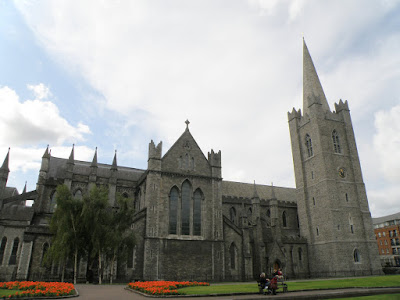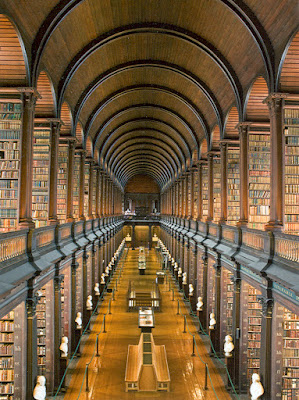Ireland
Irish Ferries has a Catamaran style Fast Ferry called the 'Dublin Swift'. From Holyhead, Wales to Dublin, Ireland, it takes less than 2 hours (1:49), but it costs 57£ for walk on passengers.
We park the car at the ferry terminal, and drop the car keys in the slot at the vacant Hertz counter.
While waiting in the terminal we meet a friendly old man traveling with rabbits. I look in on them and say they are cute, his response "they aren't cute, they'll be on a hook soon". Apparently he brings them from Wales for the old folks homes, so they can have rabbit dinners... mmmm.
After the cars load, a bus takes us to a secondary waiting area, then we walk through all the cars and up some stairs into the lounge area of the ship. The ship was already packed, but we sat near a family with 2 boys, one making good use of the sea-sick bags... poor little guy. Luckily we had a pair of comfy chairs with a view, and in no time at all, we are in Dublin.

After dragging our bags onto the ferry we are reminded of European travels via the train. Only take as many bags as you are comfortable carrying by yourself. Dublin would be only the second place that had an elevator, everywhere else involved stairs. A medium sized suitcase with rollers and a small backpack is enough to easily haul around.
Irish Ferries loads us onto a bus that takes us to the city centre, then it's a short cab ride to our hotel... I managed to find a cheap room on the web for €39 a night in the center of Dublin!!!
This was no discount hotel, it was very modern, with large clean rooms, and even a restaurant and Irish coffee shop. Right across the street from our cheap but fancy hotel is the historical Christchurch, and it's just a few minutes walk to the very popular Temple Bar area.
Dublin is split in two by the River Liffey, and a series of historical bridges bring the two halves together. The Ha' Penny Bridge is a cast-iron pedestrian bridge built in 1816, it's name coming from the ha'penny crossing toll that was charged for over 100 years. The O'Connell Bridge is a road bridge that was originally built between 1791 and 1794. After it was widened in 1879, it became unique in Europe as the only traffic bridge that was as wide as it is long.
In stark contrast to the historic bridges is the pedestrian Millennium Bridge, inaugurated in 2000.
Along the river is several historic buildings, including the neoclassical 18th century customs house, originally the home for the Dublin Ports customs office. Another landmark building is the 1802 Four Courts building (The Supreme Court, High Court, Central Criminal Court and Dublin Circuit Court).
Throughout the city of Dublin is large columned buildings, representing everything from a Post Office to libraries. It seems every building of the period had to look like a palace.
The Temple Bar area is a series of connected cobblestone streets. During the early 1900's the area declined into a slum until students and artists took over. Now it is a trendy and popular tourist area of Restaurants, pubs and shops, it is the central nightlife area of Dublin. When strolling through the Temple Bar area it is interesting to notice that the buskers are not just a 'guy and a guitar', but are actually entire bands, with a wide variety of musical stylings.
From the Temple Bar area we cross the river and head up O'Connell Street. Hard to miss is the 300 ft tall Millennium Spire, Dubliners call it the tallest waste of €5 Million. They have given it many nicknames, including; Stiletto in the Ghetto, the Stiffy on the Liffey, the Pole in the Hole, the Spike in the Dike... our salesman says it's a giant needle so the junkies know where to go

Just like in the old days of cameras and film, you have to consider how many pictures you can take with your digital camera. You can adjust the detail of your pictures to fit more on a memory card, but you may not get back here again. So plan to have lots of extra (large) memory cards, because if you have to buy them on vacation, they will be much more expensive.
Our salesman is a unique character at a camera store. After 4 weeks of being my snap-happy self, I was pretty sure I wouldn't have enough space on the memory cards I brought, Dublin seemed like the best bet to find a good deal on a 2 Gb memory card. As we are waiting for a salesman talking to 2 older ladies, he steps away from them and asks if he can help us. That is when his true Irish self comes out. "Thank god you came in, I can't waste any more time with those @%$#& ladies, they aren't buying any @%$#& thing, @%$#& milkers, gonna milk my whole @%$#& day."
So with a laugh we bought a 2 Gb memory card from the #@$%er, even though we ended up paying probably twice what they cost back in Vancouver, it was the best deal in Dublin.
Back across the Liffey, we wandered up the Grafton St. Pedestrian shopping area, past some unique buildings and unique sights, like the Stephens Green Shopping Centre.
James Bond must be on a mission in Dublin
As we continued we saw some nice areas, and some not so nice areas of Dublin. As we cut through the Meeting House square we pick up the pace as we pass a guy shooting up.
We head back towards our hotel and Christchurch to see the Evensong, but the Choir is off for the summer. It seems we are destined not to see an Evensong performance on this trip.
After touring the church and the tombs, we came out front and met the priest. Norine complimented his church and it's intricate and colourful floors that were unlike any other church we had seen. From that point on we couldn't stop him from talking. He was a friendly old man, and after learning we were from Canada he gave us a complete history lesson of Dublin. From the Vikings, to the Saxons, to the Normans... it didn't stop until his blue tooth cell phone rang,
his wife wanted him to bring home some groceries. I don't think there was much history left.
The amazingly colourful floors and pulpit of Christchurch
For dinner we headed to the Temple Bar area, It just seemed right to order Irish Stew and Irish beer on our first night in Ireland. Afterwards we checked out the crazy nightlife of drunken tourists.
After weaving our way through the crowds, we head back to our hotel for a good night's sleep.
After grabbing a Danish and Muffins for breakfast, we hauled our dirty clothes to a local Laundromat and for £12.50, someone else would clean our clothes while we played tourist.
A short walk from the laundromat is St Patrick's Cathedral, adjacent to the famous well where tradition has it Saint Patrick baptized converts on his visit to Dublin. It was founded in 1191, and is the larger of Dublin's two Church of Ireland cathedrals, and the largest church in Ireland. The Cathedral is named after St Patrick, more famous in legend for driving all the snakes from Ireland, than he is for his role as a missionary spreading the christian faith to a largely pagan populace.

From St Patrick's we head to St Stephens Green, a large public park surrounded by St Stephen Green streets... East, West, South and North. The park was opened to the public at the initiative of Arthur Guinness, you may have heard of him, he was the founder of Ireland's Guinness brewery.
On the way to Trinity College we stopped in at the 17th century Saint Ann's Church, famous for it's bread shelves behind the altar and one of it's parishioners, Bram Stoker, author of Dracula.
Official residence of the Mayor, since 1718
Trinity College (aka The University of Dublin) was founded in 1592 under direction from Queen Elizabeth I. Trinity College is one of the seven ancient universities in the English speaking world, and is the only one located outside of the present-day borders of the United Kingdom.
Inside the College is the Book of Kells, an illuminated Latin manuscript containing the four Gospels of the New Testament. It was transcribed by Celtic monks in 800 AD as pieces of art depicting the stories of the bible. After lining up to see the actual book preserved under glass, we make our way into the even more impressive 200 ft long old library stacked to the ceilings with over 200,000 ancient books. In a sealed room, staff are dusting and preserving books, one at a time.

Our next stop is Merrion square, a Georgian square laid out in 1792. It's parklands are surrounded by Georgian houses home to many famous notables of the past including the Poet W.B. Yeats and Playwright, Poet and author Oscar Wilde whose memorial takes a prominent corner of the park.
The architecture of this area is unique, with a combination of structure and artwork.
One of the most famous architectural elements of the area is the doors of Dublin. The Georgian doors are colourful and each have a unique and ornate knob and knocker. A carefully restored Georgian townhouse is at 29 Fitzwilliam St, but it had a long long wait, so we bailed.
Not far from our hotel is Dublin Castle. Most of it dates from the 18th century, though a castle has stood on the site since the days of King John, the first Lord of Ireland in the 12th century. Dublin Castle has appeared in numerous films including Barry Lyndon, Michael Collins, Becoming Jane and The Medallion, as well as the television series The Tudors, where it doubles as the Vatican.
Right in the middle of the courtyard of the castle is a sand castle competition, but not just your ordinary sandcastles, they are very elaborate sand sculptures. Each sand sculpture is based on Irish literature, I'm not sure I recognize any of these books.
Tours of the castle and State apartments are all sold out for the day, so we circle around the chapel on the castle grounds, pick up our laundry and head back to our room to relax for a bit.
After a short break we head back out into the streets of Dublin one last time. Close by is St. Audoen's 12th century Church, the oldest parish church in Dublin and it's still used as one.
The old St. Audoens church backs on to St. Audoens gate, the door into Dublin in 1240 AD.
Seemingly out of place on our walk is the Franciscan Capuchin Friary, a branch of the Franciscan Family founded by St. Francis of Assisi in 1209. I didn't think people became monks anymore.
We head back to Temple Bar one last time, we had some typical Irish drinks and enjoyed typical Irish music in a pub, then had dinner in another pub with a typical Irish band playing.
After having Irish food, with Irish music, and Irish beer, we met a leprechaun... coincidence?
On a sunny morning we caught a cab to the airport to pick up a car - and to our surprise our compact car is an Audi 3. A sharp little car that is hard to get into, but it has some oomph.
The Clutch was interesting, and quite a bit different from our Ford Focus. I stalled the car twice before we got out of the airport parking lot, but then I got the hang of it... mostly.


